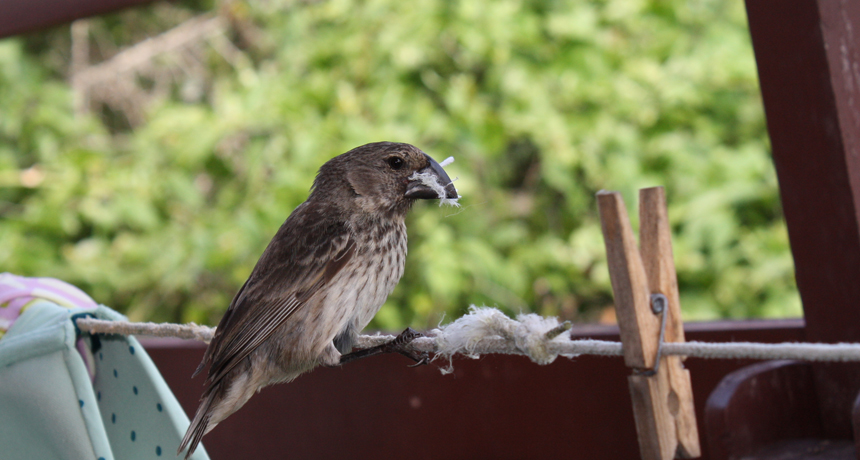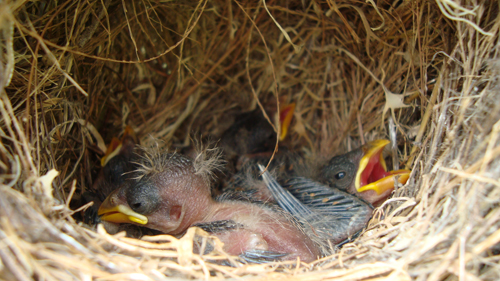Helping birds doctor their babies
An observant biologist figured out how to help birds treat their nests and kill a parasite

This mother medium ground finch is picking cotton off biologist Sarah Knutie's laundry line in the Galapagos Islands. The bird will use the cotton as nesting material, weaving it in amongst twigs and grass.
Sarah Knutie
A biologist working on the Galapagos Islands in Ecuador has come up with an unusual way to help critically endangered birds fight off a deadly insect parasite. The adult insect lays its eggs in the birds’ nests. As insect larvae emerge from those eggs, they feed on the blood of the baby birds. If they drain out too much blood, the birds will die. But Sarah Knutie tricked the parent birds into bringing an insecticide into their homes — one that would protect their fragile brood.
A biologist, Knutie is earning her PhD at the University of Utah in Salt Lake City. She’s been studying Darwin’s finches. The various islands off the west coast of Ecuador that make up the Galapagos are home to 14 species of these birds. These finches live nowhere else in the world.
The parasite that feeds on them is a fly called Philornis downsi. It is not native to the islands. The species probably stowed away on a plane or ship coming from the South American mainland at some point in the mid-1990s, says Knutie.
The adult bugs look a lot like common houseflies. They lay eggs in bird nests. When their worm-like larvae hatch, the young insects turn to a baby bird for their meals. Using their “mouths,” they drill a hole into a young bird’s stomach. They’ll feed on the blood that leaks out. But if the baby bird loses too much blood, it dies.

“It was a pie-in-the-sky, crazy idea,” says Knutie. “I wasn’t sure it was going to work.”
But it did!
The idea for this project hit her in 2010. At the time, she had been sitting on the porch of a research station in the Galapagos. She was there to study the finches and that parasitic fly. But one day Knutie noticed the birds were stealing cotton fibers for their nests from her laundry line. She wondered what would happen if that cotton contained an insecticide.
To test that, last year Knutie set up 30 rectangular wire frames stuffed with cotton balls. She put them close to where the finches were building nests. Half of the frames contained cotton treated with an insect-killing chemical. Cotton in the other half had been treated with only water.
After the birds finished breeding, she and her team checked nests for parasites.
Nests containing cotton treated with just water had on average 30 parasites. Those with cotton treated with insecticide had half as many parasites (about 15). And of the eight nests that contained at least one gram of the insecticide-soaked cotton, seven had no parasites at all. The eighth nest had only four parasites.
Knutie published her findings May 5 in Current Biology.
The biologist performed her tests with four species of finches that are not endangered. But she hopes the same technique can be used to protect two species of their critically endangered cousins, especially the mangrove finches. There are only 80 left on the planet.
“Sarah is sitting there looking at her laundry line and noticing what these finches are doing,” says conservation biologist Stuart Pimm. Then she comes up with a “simple, straightforward experiment.” As such, he notes, Knutie’s research is a great example of the importance of observing your surroundings. Pimm is an expert in extinctions and what can be done to prevent them. He works at Duke University in Durham, N.C.
Knutie says earlier studies suggest the insecticide won’t hurt birds. Other scientists on the Galapagos Islands are now doing more research to be sure of that.
“The birds have no defence against the parasite and are really suffering.” That is why, Knutie says, “humans need to step in and help.”
Power words
biology The study of living things. The scientists who study them are known as biologists.
conservation biologist A scientist who investigates strategies for helping preserve ecosystems and especially species that are in danger of extinction.
endangered An adjective used to describe species at risk of going extinct.
evolution The process by which different kinds of living organisms are thought to have developed and diversified from earlier forms during the history of the Earth. If an organism has a trait which provides them with a selective advantage (i.e. has an adaptive significance) in a new environment natural selection will likely favor it. This can include a behavior such as a song or way of communicating.
Galápagos Islands in the Pacific Ocean that belong to Ecuador and are located some 1,000 kilometers (620 miles) west of the South American mainland. Charles Darwin’s visit to the islands in 1835 and his observation of unusual animals on them inspired his theory of evolution.
insecticide A poison that kills insects.
larva (plural: larvae) An immature life stage of an insect, which often has a distinctly different form as an adult.
parasite A creature that gets a benefit from another organism, called a host, but doesn’t provide it any benefits. Classic examples of parasites include ticks, fleas and tapeworms.







